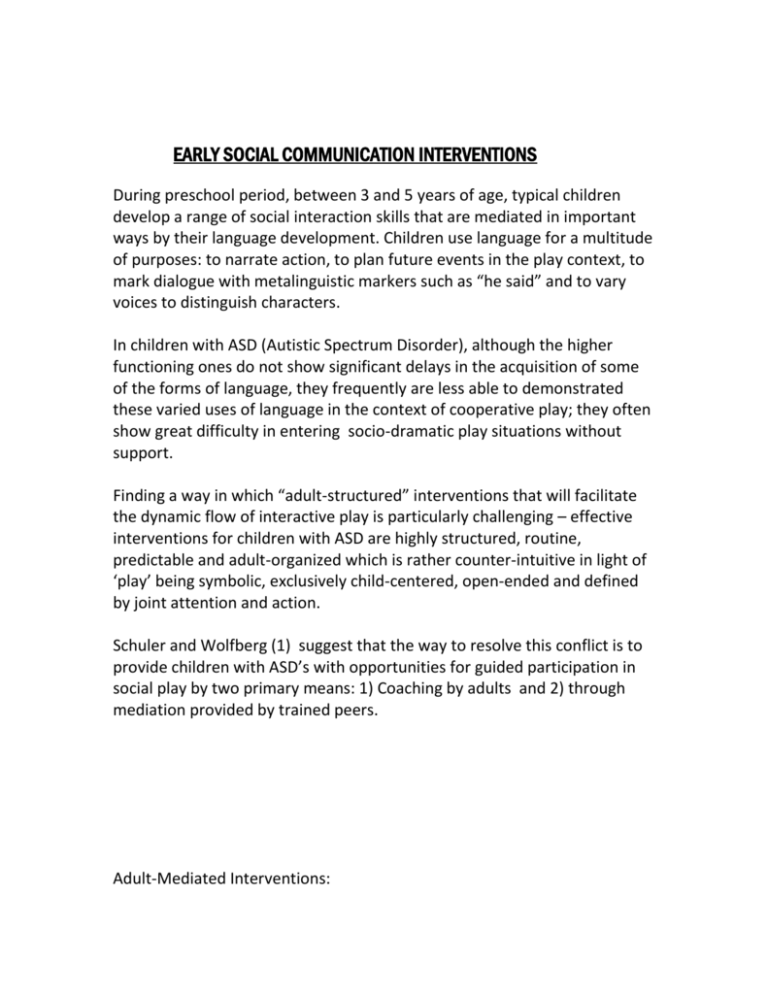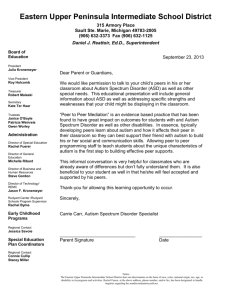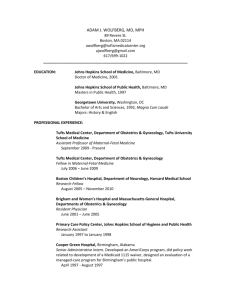EARLY SOCIAL COMMUNICATION INTERVENTIONS
advertisement

EARLY SOCIAL COMMUNICATION INTERVENTIONS During preschool period, between 3 and 5 years of age, typical children develop a range of social interaction skills that are mediated in important ways by their language development. Children use language for a multitude of purposes: to narrate action, to plan future events in the play context, to mark dialogue with metalinguistic markers such as “he said” and to vary voices to distinguish characters. In children with ASD (Autistic Spectrum Disorder), although the higher functioning ones do not show significant delays in the acquisition of some of the forms of language, they frequently are less able to demonstrated these varied uses of language in the context of cooperative play; they often show great difficulty in entering socio-dramatic play situations without support. Finding a way in which “adult-structured” interventions that will facilitate the dynamic flow of interactive play is particularly challenging – effective interventions for children with ASD are highly structured, routine, predictable and adult-organized which is rather counter-intuitive in light of ‘play’ being symbolic, exclusively child-centered, open-ended and defined by joint attention and action. Schuler and Wolfberg (1) suggest that the way to resolve this conflict is to provide children with ASD’s with opportunities for guided participation in social play by two primary means: 1) Coaching by adults and 2) through mediation provided by trained peers. Adult-Mediated Interventions: 1) restructuring teachers’ reinforcements to socially isolated children by ignoring their initiations to adults and reinforcing attention to peers 2) individual coaching using teacher prompts and praise in the context of peer play 3) peer training 4) practice in all environments in which generalization is to occur for interactive behaviors to be maintained. 5) Inclusion of pre-existing behaviors (eg, lining up objects) into play context (eg, acting as a clerk who neatens up shelves in a play store). (2) 6) “friendship activities” – an approach that typically relies on teachers prompting children to compliment and show affection for each other within the routines of school 7) Incidental teaching involves arranging the environment so that objects and activities known to interest the child are in sight but out of reach – promoting initiation of interactions by child. 8) Script-fading procedures – written cues like “look” and “watch me”, to initiate conversation with adults who only respond to conversation directed to them, requiring children to “improvise” (3) Peer-Mediated Interventions: 1) Peers are taught to present and persevere in presenting “play organizers” to classmates with ASD. Organizers consist of sharing, helping, giving affection and praising. (Peers are taught these skills in role-playing activities with adults and then are cued and reinforced by adults in play sessions with target children) (4) 2) “Buddy Skills Training Program (5) Principles of this program include having a “buddy” and teaching him to exercise three simple strategies: STAY with your buddy (maintain physical proximity) PLAY with your buddy (offered choice from choice-board and instructed to play with target kid for about 10 to 20 minutes) TALK with your buddy (say your partner’s name to establish joint attention, make suggestions for playing , talk about the play, respond to what your partner says by repeating, extending or asking more about it). SOCIAL COMMUNICATIVE INTERVENTIONS FOR SCHOOL-AGED CHILDREN During school age, children begin using language to acquire new information about objects and events with which they have no direct sensory experience (6): people talk to pre-school children about where their shoes are; they talk to school-age children about where the Andes are. There is a move away from socio-dramatic play to more topic-centered forms of interactions, such as discussing shared interests, playing games with rules. Adult Mediated Interventions: 1) Using time delay: presenting a stimulus and waiting for longer period of time before giving the child a prompt to respond (7) 2) Use of social stories: stories are written collaboratively between the child and the facilitator, usually focused on reducing maladaptive behavior – They state a problem (for instance “Waiting in line is hard”), give a reason for the socially accepted action (“The teacher needs to make sure everyone gets outside safely without pushing”), give the child an acceptable action to perform (“I can wait in line. I can think about how much fun it will be to play outside while I am waiting”), and an evaluation (“My teacher will be happy when I wait quietly in line. I will feel good when I get outside”). (8) 3) Creating group games for the ASD child based on the child’s special interest, teaching them to the target child and peers for use during free period at school. (9) 4) “Pivotal Response Training” choosing behaviors as targets that will have widespread, positive effects on a range of behaviors. For instance, using “what’s that?” as a pivotal question that will serve as initiation strategy for communication. References (1) Schuler, Wolfberg. Promoting peer play and socialization, in: Wetherby AM, Prizant BM, editors. Autism spectrum disorders: a developmental perspective. Baltimore: Paul H. Brookes; 2002 p. 251-78 (2) Wolfberg, Schuler. Fostering peer interactions, imaginative play and spontaneous language in children with autism. Child Language Teaching and Therapy 1999; 15 (1): 41 – 52 (3) Krantz, McClannahan Social interactions skills for children with autism: a script-fading procedure for beginning readersr. J. Appl Behav Anal 1998; 31:191-202 (4) Odom, Strain A comparison of peer initiation and teacher antecedent interventions for promoting reciprocal social interaction of autistic preschoolers J Appl Behav Anal 1986; 19: 59-72 Odom, McConnell, McEvoy, Peterson, Ostrosky, Chandler, et al Relative effects of interventions for supporting the social competence of young children with disabilities Topics in Early Childhood Special Education 1999; 19: 75-92 Strain, Shores, Timm Effects of peer social initiations on the ehavior of withdrawn preschool children J Appl Behav Anal 1977;10:289-98 (5) Goldstein, Wickstrom Peer intervention effects on communicative interaction among handicapped and nonhandicapped preschoolers J Appl Behav Anal 1986; 19:209-14 (6) Owens Language Development 4th Edition Boston: Allyn & Bacon; 1996 (7) Hwan, Hughes The effects of social interactive training on early social communicative skills of children with autism J Autism Dev Disord 2000;30(4):331-43 (8) Gray the new social story book Arlington (TX): Future Horizons; 2000 (9) Baker, Koegel, Koegel Increasing the social behavior of young children with autism using their obsessive behaviors J Assoc Persons with Severe Handicaps 1998; 23(4): 300-8







